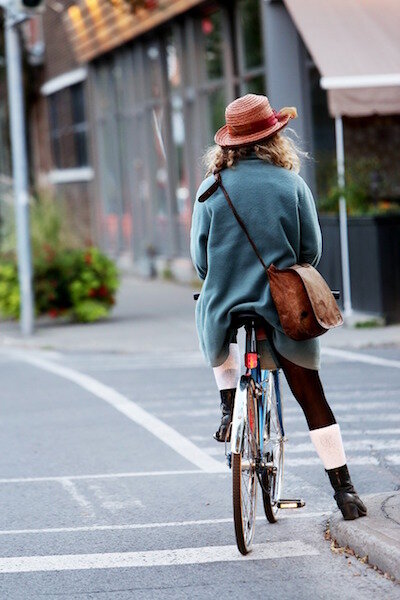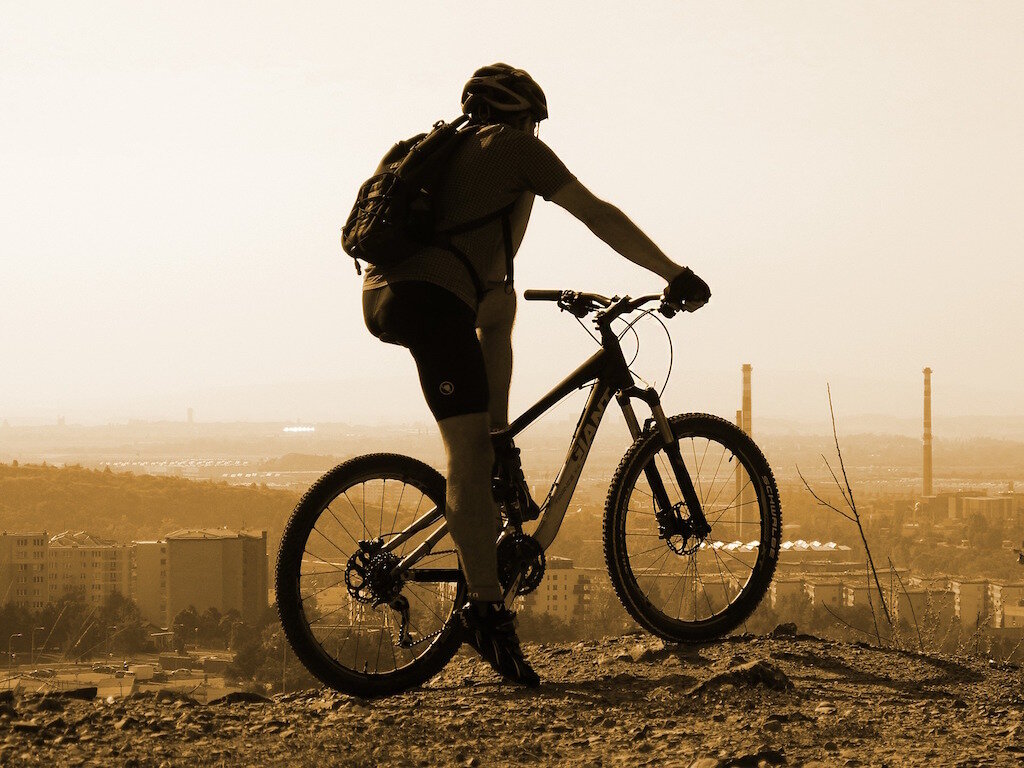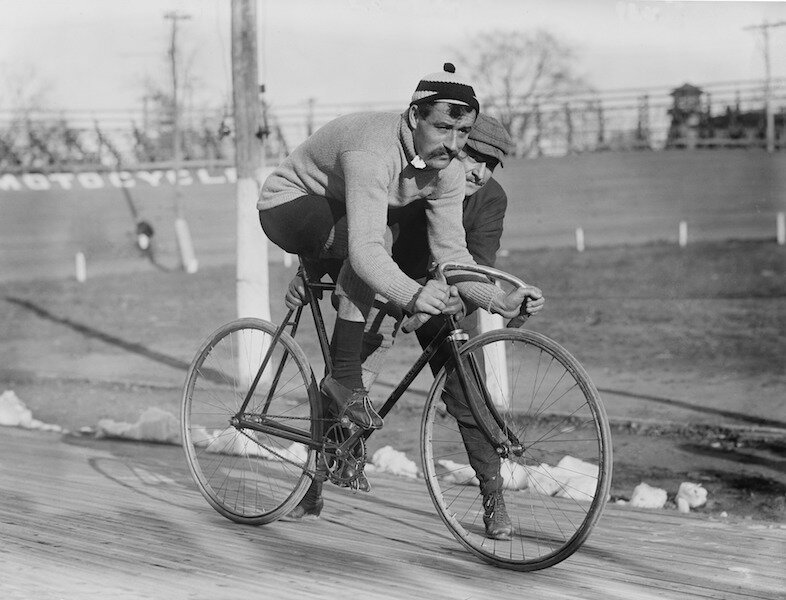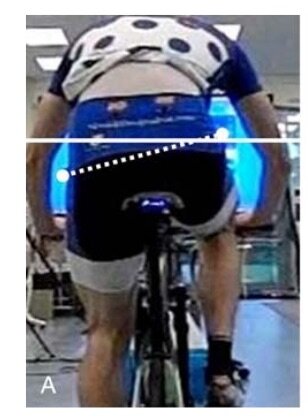Correct seat height; You can only touch the ground with your toes. Many bicycle commuters will stop and use the curb since they can’t reach the ground without a “boost.”
“Usually, you cannot touch the ground with both feet when sitting on the saddle - but you should be able to reach the floor with the ball of one foot”
Proper saddle height is very important.
Too low of a saddle is hard on your knees and is very inefficient. Too high of a saddle and you can’t get any leverage on the pedal cranks and is very uncomfortable.
Either way, a saddle that is too far up or down is bad, uncomfortable, inefficient, and will eventually lead to injuries or pain.
Should my feet touch the ground on a bicycle when I’m sitting in the seat/saddle?
For most styles of bicycles, including road, gravel, and mountain bikes, you’re at the CORRECT saddle height when you can only touch the ground with the TIPS of your toes while your ankles are flexed with your toes pointed downward (see pic below).
If you can sit on your bike seat with your feet flat on the ground, then your saddle is much too low.
Notice this mountain biker can only touch with the tips of his toes while reaching down with his foot. This cyclist is riding with a correct saddle height
The only time your feet should be flat on the ground is when you are straddling a bike while sizing it.
Image Source: Specialized Bicycle Owner's Manual
Above are the instructions from the Specialized Bicycle Owner’s Manual.
Basically, your crotch should be 2 to 6 inches higher than the frame when straddling the bike. Once you go from straddling the frame to straddling the saddle, you should only be able to reach the ground while being on your tippy-toes.
bicycle seat too low
This rider is all bunched up with knees going into his chest. This saddle is too low.
It’s very common for beginner and intermediate cyclists to ride with their seat too low since they feel more comfortable being able to reach the ground.
However, riding with a saddle that is too low reduces pedal efficiency and overtime causes knee problems.
“Biker’s Knee” or Patellofemoral Pain Syndrome (PFPS) is the most common knee injury to cyclists and is caused in part, by riding with the saddle too low.
Saddle Too Low & Problems
Pain in the front of the knee or on the kneecap (patella)
More common in recreational riders than amateur or professional cyclists
Caused from riding with too low of a saddle or sitting too far forward in the saddle
Saddle Too Low = Knee is more flexed = causes compression of the patella against the underlying surfaces = excessive amount of shear forces pulling the patella = anterior knee pain
Limited knee extension = reduced pedal efficiency and power
Reduced Efficiency - You will have “smaller” pedal strokes, which means you will need to pedal more to maintain the same speed as your friends
Less Power - It’s hard to generate any serious power when you’re essentially turning your long legs (levers) into short legs (levers)
Bicycle saddle too high
Seat too high. Zero bend in my knee and can barely reach pedal even when scooting up on the saddle
Riding with a saddle that is too high is just as bad as riding with one that’s too low, but for different reasons.
Saddle Too High & Problems
Saddle sores: Hips rock back and forth against the saddle causing sores (and a waste of energy)
Causes pain behind the knee from overextending
Uncomfortable from over-reaching and excessive rubbing on the seat
Not a very powerful position as your trying to spin the pedals from a very weak position
Image Source: (Leavitt and Vincent)
You know the seat is too high when your riding and your hips are rocking back and forth.
In the above picture, this cyclist has a saddle that is too high as he has excessive hip motion or rocking. However, you don’t want to eliminate all hip motion, since the ideal amount of pelvis movement transfers more power to your legs.
Optimal saddle height
Image source: The Cannondale Bicycle Owner’s Manual
There are numerous formulas and techniques for finding your proper saddle height, such as the Hamley, Lemond, Holmes, Pruitt, and heel-toe methods.
Finding your seat height quickly & easily: Heel-toe method
The heel-toe method is the quickest and easiest way to find your approximate ideal saddle height and also requires no specialized equipment.
The heel-toe method:
Sit on the bicycle with both feet on the pedals
Prop yourself up (hang onto a wall, use a trainer, or ask a friend to help)
Pedal backward until:
The bottom pedal is in the 6-o’clock position
The top pedal is in the 12-'o’clock spot
Place your heel on the low pedal and your leg should be fully extended
Go for a ride. When you spin the pedals your leg should have a slight bend (25 - 40 degree knee angle) while in the bottom position
This is just an approximate starting point and you can make adjustments up or down, from this position
Most bicycle owner’s manuals use this method. Below is the heel-toe method, with instructions, from the Specialized Owner's Manual.
Image Source: Specialized Bicycle Owner's Manual
Final Thought
Of all the bike fit adjustments, saddle height is considered the most important.
Optimal seat height allows you to maximize every spin of the pedals while keeping your knees healthy. You will make over 7,200 pedal revolutions in just a leisurely 2-hour bike ride. If your seat isn’t set properly, your body will let you know.
Jesse is the Director of Pedal Chile and lives in Valdivia, Chile. Jesse has a Master of Science in Health & Human Performance and a Bachelor of Science in Kinesiology. Hobbies: Mountain biking, bicycle commuting, snowboarding, reading, weight-lifting, taster of craft beers, & researching.
Sources & References
Cannondale Bicycle Corporation. Bicycle Owner’s Manual.
Doughty, Simon. The Long Distance Cyclist’s Handbook. London, A & C Black, 2002.
Kronisch, Robert L. “How to Fit a Mountain Bike.” The Physician and Sportsmedicine, vol. 26, no. 3, Mar. 1998, pp. 71–72, 10.1080/00913847.1998.11440350.
Leavitt, Trevor G., and Heather K. Vincent. “Simple Seat Height Adjustment in Bike Fitting Can Reduce Injury Risk.” Current Sports Medicine Reports, vol. 15, no. 3, 2016, p. 130.
Specialized Bicycle Components, Inc. OWNER’S MANUAL SPECIALIZED BICYCLE. 2007.
Trek Bikes. “Owners Manual - Fitting Your Bicycle | Trek Bikes.” Trekbikes.Com, 2020.


















